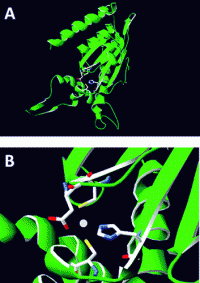A new 'Achilles' heel' in fungus that causes dandruff

Research on the fungus that ranks as one cause of dandruff — the embarrassing nuisance that, by some accounts, afflicts half of humanity — is pointing scientists toward a much-needed new treatment for the condition's flaking and itching. The advance is the topic of a report in ACS' Journal of Medicinal Chemistry.
Claudiu T. Supuran and colleagues explain that dandruff involves an excessive shedding of dead skin cells from the scalp. In people without dandruff, it takes about 30 days for a crop of new skin cells to mature, die and shed. In people with dandruff, it may take only 2-7 days. Irritation by the scalp-dwelling fungus Malassezia globosa (M. globosa) is one cause of dandruff. Shampoos and other dandruff treatments contain anti-fungal agents, but the authors say new medicines are badly needed since the two existing compounds are not very effective at preventing and treating dandruff.
In the quest for a better treatment, Supuran's group identified an enzyme in M. globosa that is essential for the fungus's growth. Tests showed that sulfonamides, a family of existing antibiotic medicines, were more effective in preventing the fungus's growth than ketoconazole, a widely used anti-fungal medicine that is an ingredient in certain dandruff treatments. As a result of the study, the scientists believe that the enzyme is a prime target for developing better anti-dandruff medicines.
More information: “Molecular Cloning, Characterization and Inhibition Studies of a β-Carbonic Anhydrase from Malassezia globosa, a Potential Antidandruff Target” J. Med. Chem., 2012, 55 (7), pp 3513–3520. DOI: 10.1021/jm300203r
Abstract
A β-carbonic anhydrase (CA, EC 4.2.1.1) from the fungal pathogen Malassezia globosa has been cloned, characterized, and studied for its inhibition with sulfonamides. This enzyme, designated MG-CA, has significant catalytic activity in the CO2 hydration reaction and was inhibited by sulfonamides, sulfamates, and sulfamides with KI in the nanomolar to micromolar range. Several sulfonamides have also been investigated for the inhibition of growth of M. globosa, M. dermatis, M. pachydermatic, and M. furfur in cultures, whereas a mouse model of dandruff showed that treatment with sulfonamides led to fragmented fungal hyphae, as for the treatment with ketoconazole, a clinically used antifungal agent. These data prompt us to propose MG-CA as a new antidandruff drug target.
Journal information: Journal of Medicinal Chemistry
Provided by American Chemical Society
















